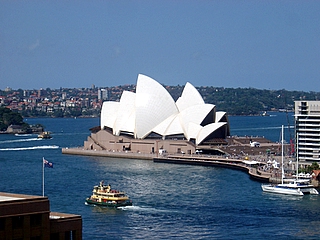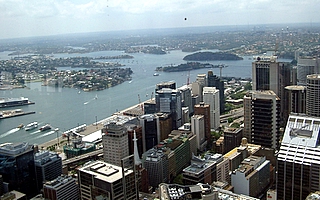Might you be the type that goes somewhere new and ends
up only seeing the designated and well known tourist sites? There is,
of course, nothing wrong with that , as it is actually a pretty good
way to get acquainted with a place. But it’s also nice to experience
the natural perspective; to get to know the origins of a place and see
how it was, even before development. Sydney, the largest city in the
Southern Hemisphere, is a superb place to do this, and all by using
public transport to boot. Sydney is surrounded by incredible and
historic National Parks, and wonderful walking trails right around the
gorgeous harbour. You can spend 2 weeks hiking around Sydney and
surrounds and not need a car to get to any of them.
 Start in Sydney’s south at the Royal National
Park, the 2nd oldest national park in the world, after Yellowstone. On
Sunday’s you can take the train to Loftus station and then get a tram
right into the park. It’s a short walk from the tram to the visitor’s
centre, where maps and information about trails are provided.
Start in Sydney’s south at the Royal National
Park, the 2nd oldest national park in the world, after Yellowstone. On
Sunday’s you can take the train to Loftus station and then get a tram
right into the park. It’s a short walk from the tram to the visitor’s
centre, where maps and information about trails are provided.
There are 3-4 wonderful trails that lead right out from
the visitor’s centre and take you along differing and beautiful vistas.
Some of the views are breathtaking and at the same time let you imagine
a Sydney before high-rises and a sprawling suburbia.
 Some trails are challenging, but there is something for everyone and
you can spot many native animals in their natural habitat (just steps
from the visitor’s centre we spotted a Lyre bird, several rainbow
lorikeets and rosellas, white cockatoos as well as the more rare black
variety). It is quite calming listening to all the sounds of the bush
and to know that in one hour you can be back in the city centre and be
shopping in some of the best stores and eating in the best restaurants.
Available too are hire boats to row on the lake, picnic areas and a
place to buy a meat pie, should all that walking make you hungry for
some good Aussie tucker.
Some trails are challenging, but there is something for everyone and
you can spot many native animals in their natural habitat (just steps
from the visitor’s centre we spotted a Lyre bird, several rainbow
lorikeets and rosellas, white cockatoos as well as the more rare black
variety). It is quite calming listening to all the sounds of the bush
and to know that in one hour you can be back in the city centre and be
shopping in some of the best stores and eating in the best restaurants.
Available too are hire boats to row on the lake, picnic areas and a
place to buy a meat pie, should all that walking make you hungry for
some good Aussie tucker.
You can also get a train north of the city to Mt.
Kuringah Chase National Park and walk to the trail from the local train
station (we also saw several birds there and a very tame Kookaburra
that came right up to us). Although rare, you should always be wary of
snakes and spiders, but all the trails are well defined and often used.
 It’s also good to know the Harbour foreshore and most beaches now have
wonderful walking trails as well. You can walk from Darling Harbour,
around The Rocks and Circular Quay and around to Mrs. Macquarie’s Chair
and Darlinghurst along one trail and take the ferry to Taronga Zoo on
the other side and walk still another trail there.
It’s also good to know the Harbour foreshore and most beaches now have
wonderful walking trails as well. You can walk from Darling Harbour,
around The Rocks and Circular Quay and around to Mrs. Macquarie’s Chair
and Darlinghurst along one trail and take the ferry to Taronga Zoo on
the other side and walk still another trail there.
Or you can catch the ferry to Manly and get information
at their visitor’s centre about several hikes in that area, including
one to North Head.
The beaches on the south side of the city also have
long walks that can take you past several other beaches. There is a
famous one that starts at Bondi beach (accessible by bus and train) and
goes south past several famous beaches with spectacular views. It even
passes a famous and surprisingly impressive cemetery on the cliffs.
A train to Kogarah, a bus to Sans Souci and a walk
along the coast of Botany Bay for several miles will take you to
Rockdale and beyond.
Another can’t miss beach is Cronulla in the city’s
south. It isn’t as well known as Bondi or Manly but many like it better
and say it’s more beautiful. Take the train right there and walk south
past more gorgeous beaches like Shelly Beach. From Cronulla, catch a
ferry to Bundeena. There are several miles of trails there that go past
breathtaking beaches, through incredible bush land, along awesome
cliffs and even past Aboriginal rock carvings. You get the point. Along
most of these walks you experience the incredible natural beauty of
Sydney, see beautiful and unique wildlife, experience Australia’s rich
history and get an amazing workout, all for the price of a bus, train
or ferry ticket.
If you are willing to venture 2-3 hours out of the city
you can visit the Blue Mountains National Park. There you take a train
and then a local bus drops you off at the trail heads. You can spend
all day walking the different trails here, taking in the truly
delicious views, including the famous three sisters rock formation.
Consider staying in Katoomba overnight and exploring more of the park
the next day.
Everything is very easy to get to and there is ample
information at visitor’s centres, tourist information centres or even
the airport or hotels. Of course the Internet is a good way to print
out trail and park maps or even bus and rail schedules.
So you can’t limit yourself in Sydney even if you
wanted to. Sydney’s natural wonders are just as rewarding, enjoyable
and accessible as are its traditional attractions. Happy hiking.

 Start in Sydney’s south at the Royal National
Park, the 2nd oldest national park in the world, after Yellowstone. On
Sunday’s you can take the train to Loftus station and then get a tram
right into the park. It’s a short walk from the tram to the visitor’s
centre, where maps and information about trails are provided.
Start in Sydney’s south at the Royal National
Park, the 2nd oldest national park in the world, after Yellowstone. On
Sunday’s you can take the train to Loftus station and then get a tram
right into the park. It’s a short walk from the tram to the visitor’s
centre, where maps and information about trails are provided.  Some trails are challenging, but there is something for everyone and
you can spot many native animals in their natural habitat (just steps
from the visitor’s centre we spotted a Lyre bird, several rainbow
lorikeets and rosellas, white cockatoos as well as the more rare black
variety). It is quite calming listening to all the sounds of the bush
and to know that in one hour you can be back in the city centre and be
shopping in some of the best stores and eating in the best restaurants.
Available too are hire boats to row on the lake, picnic areas and a
place to buy a meat pie, should all that walking make you hungry for
some good Aussie tucker.
Some trails are challenging, but there is something for everyone and
you can spot many native animals in their natural habitat (just steps
from the visitor’s centre we spotted a Lyre bird, several rainbow
lorikeets and rosellas, white cockatoos as well as the more rare black
variety). It is quite calming listening to all the sounds of the bush
and to know that in one hour you can be back in the city centre and be
shopping in some of the best stores and eating in the best restaurants.
Available too are hire boats to row on the lake, picnic areas and a
place to buy a meat pie, should all that walking make you hungry for
some good Aussie tucker.  It’s also good to know the Harbour foreshore and most beaches now have
wonderful walking trails as well. You can walk from Darling Harbour,
around The Rocks and Circular Quay and around to Mrs. Macquarie’s Chair
and Darlinghurst along one trail and take the ferry to Taronga Zoo on
the other side and walk still another trail there.
It’s also good to know the Harbour foreshore and most beaches now have
wonderful walking trails as well. You can walk from Darling Harbour,
around The Rocks and Circular Quay and around to Mrs. Macquarie’s Chair
and Darlinghurst along one trail and take the ferry to Taronga Zoo on
the other side and walk still another trail there.